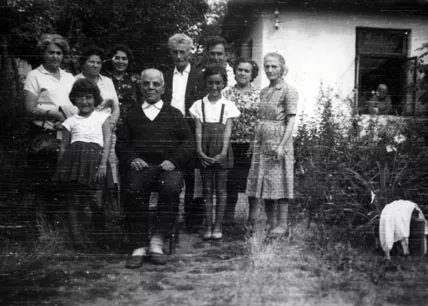After a lot of Jews left for Israel in 1948-1950 we had new neighbors. This is a photo of my parents Mihael and Sarina Kohen with our new neighbors. My father Mihael Kohen is sitting, on his two sides are my daughters Jana (on the left) and Rina Kohen. The photo was made in 1963 in Sofia. The photo also shows our neighbors Metodi and Milka Shlaganovi, with whom we got along very well. My mother Sarina Kohen is first from left on this photo. It was taken in Sofia in 1963.
My grandfather's house was on 12 Slivnitsa Street. Later the street was renamed to 7 Gyueshevo Street. Our house was made of adobe and at first it had only one room and an entrance hall. Later another room was added as well as another extension, which was the house of my uncle Rafael Kohen. My father's elder brother Eliya Kohen also lived in that yard. His house was the most solid one. My father Mihael Kohen took a half of one of my grandfather's rooms and enlarged it. He also built another room with a small entrance hall where he lived with his family. There were some inconveniences. The toilets were outside and we had no running water inside. There was a tap on the street which we used. We had electricity. Later we had running water in the yard, but not in the house. The street, on which we lived became all muddy when it rained. And so did most of the streets in the Jewish neighborhood.
My father Mihael Kohen tried many things in life. He spent eight years in captivity during World War I. He was held captive by the French army near Thessaloniki as a soldier from the Bulgarian army. After that he worked as a tinsman. He took part in the construction of the roof of the first building of the Sofia University. He traded with second-hand products. Later, together with an uncle of my mother's Chelebi Haravon, and with the active help of my uncle Mois Haravon, he managed to set up a haberdashery on Lomska Street [present-day George Washington Street, near the central Sofia synagogue], but those were the years of the great crisis in 1929-1932 and he was forced to close it down. Then he started work as a street vendor and walked around the neighborhood with a tray selling elastic cords, tights and haberdashery. Then he made a warehouse selling coal near our house. At that time people could not afford to buy a lot of coal and came to buy 5-10 kilos. In this way my father was able to support us and helped the people in the neighborhood. That continued until the passing of the anti-Jewish laws when he was forbidden to work.
My mother was clever and hard-working. She read books in Ladino. I think she got the books from acquaintances. At home we had Bulgarian literature, which we took from the community houses. There was a Jewish community house on Klementina Boulevard [present-day Stamboliiski Blvd] and on Lege Str. I also took books from the Bulgarian community house on the corner of Tsar Simeon Str. and Bregalnitsa Str. Its name was 'Hristo Botev'. Thanks to my mother I learned to read a little in Ladino in Rashi. She had a beautiful handwriting and expressed herself very well. Her Bulgarian was also very good. Uncle Mois Haravon also expressed himself very well. He wrote to us very good letters in Bulgarian from Israel.
After September 9th 1944 we did not stop celebrating the Jewish holidays. We have a tradition to gather with our children. We have always lit candles on Chanukkah. My mother went to the synagogue when she could. Even when she was not able to go there by herself, we drove her and then we took her back. I did not have any problems to accompany my mother to the synagogue. It could have had negative consequences, but I personally did not have any problems. During totalitarianism the religious followers were persecuted. Yet, I have not heard of any Jews arrested for visiting the synagogue. My mother died in 1991. She went regularly to the synagogue until 1990.


















































